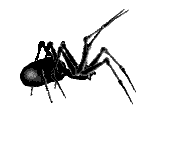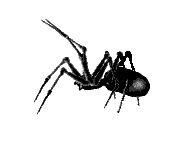


This page of links is maintained as a special section of the excellent
Arachnology
Home Page. If you have a relevant link to contribute to this
page, please send it along and
I will include it here. Links relating to the conservation of other arachnids
are also desired.
If you have entered via the Arachnology site, don't forget to also
visit my main Spider Conservation page.
Links Index
 Spider
Conservation (North America)
Spider
Conservation (North America)
-
NatureServe®
is a source for authoritative conservation information on more than 50,000
plants, animals, and ecological communities of the United States and Canada.
NatureServe is provided by the Association
for Biodiversity Information (ABI) a non-profit organization dedicated
to developing and providing knowledge about the world's natural diversity.
While
compiled data on spiders is admittedly sparse, 343 spider species are tracked
in these databases, including 108 at risk species. Decent ecological
and conservation status reports are available for USESA-listed species
or candidates and rarer species. (USA)
-
State-wide spider surveys that enlist amateurs can help fill critical data
gaps. The Colorado
Spider Survey is a means of gathering critical information about the
ecology and distribution of the spiders of Colorado. Denver Museum
of Natural History (USA)
-
Similarly, the Ohio
Spider Survey (with newly redesigned web pages) is gathering
data on the ecology and distribution of the spiders of Ohio. The
Ohio State University-Marion (USA)
-
Many spiders of conservation concern are cave-adapted troglobites. Read
more about the special needs of these and other cave and karst-associated
species at the
Biospeleology
site of the Texas Memorial Museum. The biodiversity
of cave and karst and their conservation
are discussed. A preprint
of a paper by William Elliot on "Conservation of the North American
Cave and Karst Biota" is available. The University of Texas at Austin (USA)
-
The Tooth
cave spider (Neoleptoneta myopica) is listed on the U.S. Endangered
Species Act. Texas Parks and Wildlife (USA)
-
An article, "Spiders
lend a leg to biodiversity: Zoologists simulate habitat fragmentation
to unravel nature's mechanisms for maintining diverse habitats" by Brecken
Lesniewski which discusses experiments being performed by Ann
Rypstra and Sam Marshall. Compass 1997: Directions of the Arts
and Sciences at Miami University (USA)
-
The Louisville Zoo
is involved in captive breeding programs for a number of endangered species,
including two threatened spiders: the Spruce-fir moss spider and the Mexican
redkneed tarantula. Louisville Zoological Garden, Kentucky (USA)
Return to Index
 Spider
Conservation (International)
Spider
Conservation (International)
-
Nine papers and an editorial from a symposium
entitled "Issues in Spider Conservation" held at the 1998 meeting of the
Society of Conservation Biology in Sydney, Australia are currently available
online in PDF format. Journal of Insect Conservation. (Netherlands)
-
Paper abstracts from a symposium
entitled "Issues in Spider Conservation" that was held at the 1998
meeting of the Society of Conservation Biology in Sydney, Australia are
available on this site. (USA)
-
The International
Kuril Island Project is an international collaboration of American,
Russian, and Japanese scientists to survey the plants, insects, spiders,
freshwater and terrestrial mollusks, freshwater fishes, amphibians, reptiles,
birds, and mammals of the Kuril Archipelago. Survey teams include arachnologists
from each country. University of Washington (USA)
 Spider
Conservation (Africa)
Spider
Conservation (Africa)
 Spider
Conservation (Asia)
Spider
Conservation (Asia)
 Spider
Conservation (Australia)
Spider
Conservation (Australia)
-
Biodiversity
of Australasian Ground Spiders This project project entails preparing
monographs covering the Australian ground spiders of the superfamily Gnaphosoidea.
These spiders are among the most abundant and important predators in both
forest and drier habitats throughout Australia, Tasmania, New Caledonia
and New Zealand. American Museum of Natural History (USA)
-
An extinct
spider from Australia (Hadronyche pulvinator). Department of
Environment & Land Management (Australia)
 Spider
Conservation (Europe)
Spider
Conservation (Europe)
-
The Cave
Spider Website summarizes information on cave spiders and their habitats
in Europe. Andreas Rohner (Switzerland)
-
Aracnis
provides an excellent overview of spiders and their relatives and promotes
an understanding of spider ecology and conservation by mirroring some links
developed from this site. Pedro Miguel Bondoso Cardoso (Portugal)
 Spider
Conservation (Latin America)
Return to Index
Spider
Conservation (Latin America)
Return to Index
 Arachnologists
With a Conservation Interest
Arachnologists
With a Conservation Interest
-
Miquel A. Arnedo
is studying the patterns of maintenance and extinction of species using
isolated ecosystems (such as islands and caves) as models. University of
Hawaii (USA)
-
James
E. Carrel studies the chemical ecology of insects, spiders and millipedes
and is conducting quantitative ecological studies of rare wolf spiders
that are endemic to the xeric, sandyridges of central Florida. University
of Missouri, Columbia (USA)
-
Jonathan
Coddington performs research spanning three broad topics: the systematics
and evolution of spiders, especially orbweavers; issues in systematic theory
and method; and, most recently, the theory and design of biological inventories.
National Museum of Natural History (USA).
-
James
Cokendolpher is a specialist on several orders of arachnids, with a
particular interest in threatened cave species.
His site contains a list of papers, some abstracts and full-text, as well
as copies of several unpublished reports (USA)
-
Frederick
A. Coyle has performed research in systematics, evolution, and natural
history of spiders. His interests include the biodiversity and conservation
biology of southern Appalachian spiders, including research that is the
foundation of knowledge on the endangered Spruce-fir moss spider.
He is currently working on a survey of the spiders of the Great Smoky Mountains
National Park Biosphere Preserve. This research addresses questions about
biodiversity inventory design and analysis at the landscape level. Western
Carolina University, North Carolina (USA)
-
Iain Downie
works on a project that assesses invertebrate biodiversity (spiders and
carabids) in agricultural land in Scotland. The aim of this work is to
produce a set of predictive models which will enable planners to make more
detailed decisions regarding biodiversity in future policy changes. Scottish
Agricultural College (Scotland)
-
Rosemary Gillespie
has studied the effects of alien species on endemic spiders (Tetragnatha
spp.) in Hawaii. Her current research focuses on studying Happy-faced spiders
(Theridion grallator) and the conservation needs of insular fauna.
University of Hawaii (USA)
-
Charles
E. Griswold has researched spider biogeography and distributions (especially
in Africa) and techniques for estimating and comparing spider species richness.
California Academy of Sciences Golden Gate Park (USA)
-
Joel M.
Harp played a vital role in getting
the Spruce-fir moss spider listed as Endangered in the U.S. His research
is in arachnology including behavioral ecology of spiders and histology
and ultrastructure of the spider digestive tissue. Oak Ridge National Laboratory,
Tennessee (USA)
-
 Marshall Hedin has studied the evolutionary patterns of biodiversity
using cave-dwelling spiders, a group of rare and potentially threatened
spiders. San Diego State University (USA)
Marshall Hedin has studied the evolutionary patterns of biodiversity
using cave-dwelling spiders, a group of rare and potentially threatened
spiders. San Diego State University (USA)
-
Frank
Howarth has examined the effects of alien species and the special conservation
needs of cave fauna. His work is also the foundation of knowledge for an
Endangered Species Act candidate species, the Kauai cave wolf spider (Adelocosa
anops). Bishop Museum, Hawaii (USA)
-
Jean-Pierre
Maelfait has studied spiders as indicators of biodiversity and heavy
metal contamination and the genetic effects of fragmentation on populations.
His research has been focused on the Lycosidae of Europe and the Galapagos
Islands. Institute of Nature Conservation (Belgium)
-
 Kimberly N. Russell (Norris) is interested in biological monitoring
in terrestrial systems, arthropod conservation, invasive species, automated
species identification of spiders. Columbia University (USA)
Kimberly N. Russell (Norris) is interested in biological monitoring
in terrestrial systems, arthropod conservation, invasive species, automated
species identification of spiders. Columbia University (USA)
-
Ann
Rypstra has studied the ecology of spiders in agroecosystems, and is
currently examining the effects of fragmentation on spider populations.
Miami University, Ohio (USA)
-
Andrei
V. Tanasevitch studies systematics, biodiversity and zoogeography of
spiders, and the conservation of endangered arachnids. (Russia)
-
David Wise
is an ecologist who studies spiders and other arthropod generalist predators
with a focus on resource limitation, competition and predator-prey dynamics.
He has written an extensive review of spider ecology, Spiders
in Ecological Webs. University of Kentucky (USA)
Return to Index
 Utilitarian
Value of Spiders
Utilitarian
Value of Spiders
Return to Index
 Related
Conservation Publications and Organizations
Related
Conservation Publications and Organizations
-
The Xerces Society
is an international, nonprofit organization focused on public education
about invertebrates and conservation projects that demonstrate their critical
roles in endangered ecosystems around the globe.
-
The Invertebrate
Conservation Research Centre is aimed at undertaking research that
directly enhances the continued survival of invertebrates, especially insects.
This site includes an extensive publication list of Michael Samways. University
of Natal, Pietermaritzburg (South Africa).
-
Sonoran Arthropod Studies
Institute is a private not-for-profit environmental and science education
institution that fosters an awareness, knowledge and appreciation of all
nature through the study and interpretation of the vital roles arthropods
play in the Sonoran Desert ecosystem. SASI hosts an "Invertebrates
in Captivity Conference" each year, which has often included presentations
on arachnid display, husbandry, conservation and education. Sonoran Artropod
Studies Institute, Arizona (USA).
Return to Index
Page administered by Kevin
L. Skerl.
 [Spider Conservation Home]
[What's New?] [Why conserve
spiders?][Legal Protection] [Case
Studies] [Links] [Bibliography]
[Author]
[Spider Conservation Home]
[What's New?] [Why conserve
spiders?][Legal Protection] [Case
Studies] [Links] [Bibliography]
[Author]
Spider animations in title created by Lisa Konrad at
the Animation Arthouse.
This page last updated on March 26, 2004.
Copyright © 1997-2004 Kevin L. Skerl. All
rights reserved.


